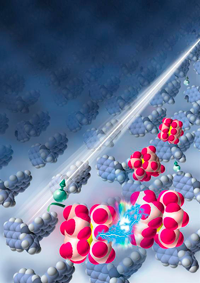 Work by researchers from Princeton University, the Georgia Institute of Technology and Humboldt University in Berlin is pointing the way to possibly more widespread use of organic electronics.
Work by researchers from Princeton University, the Georgia Institute of Technology and Humboldt University in Berlin is pointing the way to possibly more widespread use of organic electronics.
Their research, which was recently published in Nature Materials, focuses on organic semiconductors, a class of materials for seen as being used in emerging technologies such as flexible electronics, solar energy conversion, and high-quality colour displays.
In the short term, the advance could help with organic light-emitting diodes that operate at high energy to emit colours such as green and blue.
"Organic semiconductors are ideal materials for the fabrication of mechanically flexible devices with energy-saving low temperature processes," said Xin Lin, a doctoral student and a member of the Princeton research team. "One of their major disadvantages has been their relatively poor electrical conductivity, which leads to inefficient devices with a shorter operating lifetime than required for commercial applications."
In the doping process used to make semiconductors their chemical makeup is modified by adding a small amount of chemicals or impurities. By carefully choosing the type and amount of dopant, researchers are able to alter the electronic structure and electrical behaviour of the semiconductor in a number of ways.
The researchers have developed an approach that greatly increases the conductivity of organic semiconductors, which are formed of carbon-based molecules rather than silicon atoms. The dopant, a ruthenium-containing compound, is a reducing agent, which means it adds electrons to the organic semiconductor as part of the doping process. Their addition is the key to increasing the semiconductor's conductivity.
The compound belongs to a newly-introduced class of dopants called dimeric organometallic dopants. Unlike many other reducing agents, these dopants are stable when exposed to air but still work as strong electron donors both in solution and solid state.
Seth Marder and Steve Barlow from Georgia Tech, who led the development of the new dopant, called the ruthenium compound a "hyper-reducing dopant." They said it is unusual, not only its combination of electron donation strength and air stability, but in its ability to work with a class of organic semiconductors that have previously been very difficult to dope. In studies conducted at Princeton, the researchers found that the new dopant increased the conductivity of these semiconductors about a million times.
The ruthenium compound is a dimer, which means it consists of two identical molecules, or monomers, connected by a chemical bond. As is, the compound is relatively stable and, when added to these difficult-to-dope semiconductors, it does not react and remains in its equilibrium state. That posed a problem because to increase the conductivity of the organic semiconductor, the ruthenium dimer needs to split and release its two identical monomers.
The researchers looked for different ways to break up the ruthenium dimer and activate the doping, eventually they added energy by irradiating with ultraviolet light, which effectively excited the molecules in the semiconductor and initiated the reaction. Under exposure to the light, the dimers split into monomers, and the conductivity rose.
"Once the light is turned off, one might expect the reverse reaction to occur" and the increased conductivity to disappear, Marder saidl. "However, this is not the case."
The researchers found that the ruthenium monomers remained isolated in the semiconductor even though thermodynamics should return the molecules to their original configuration as dimers.
The team’s hypothesis is that the monomers are scattered in the semiconductor in such a way that it is very difficult for them to return to their original configuration and re-form the ruthenium dimer. They are, according to the team “kinetically trapped."
The researchers also discovered that doping was continuously re-activated by the light produced by the device. The light activates the system more, which leads to more light production and more activation until the system is fully activated, Marder said. "This alone is a novel and surprising observation."
Pic: Researchers used ultraviolet light to excite molecules in a semiconductor, triggering reactions that split up and activated a dopant.
Author
Neil Tyler
Source: www.newelectronics.co.uk
